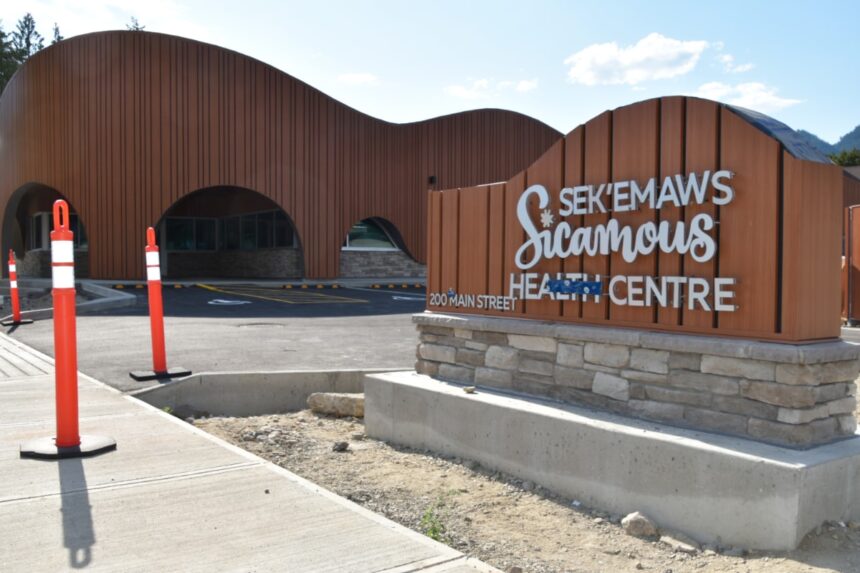The Eagle Valley hums with anticipation as I make my way up Highway 1 toward Sicamous. Nestled between Shuswap and Mara Lakes, this community of just over 2,000 residents has waited years for what many urban Canadians take for granted – consistent access to primary healthcare close to home.
Today marks a milestone. The doors of the Sekemaws Health Centre are officially open, bringing comprehensive healthcare services to a region that has struggled with physician shortages and limited medical infrastructure. Community members begin arriving early, some parking their vehicles at the edge of the lot, others walking from nearby neighborhoods.
“This isn’t just a building. It’s security for our future here,” says Eleanor Whitman, a 73-year-old Sicamous resident who tells me she’s lived in the area for over four decades. Until now, she’s had to travel to Salmon Arm for most medical appointments – a journey that becomes particularly challenging during winter months when mountain roads demand extra caution.
The $3.5 million facility represents a collaborative effort between the District of Sicamous, Interior Health, and the provincial government. Unlike traditional medical clinics, this 4,500-square-foot centre integrates multiple health services under one roof, including primary care physicians, mental health counseling, public health nursing, and laboratory services.
Mayor Colleen Anderson addresses the crowd gathered for the ribbon-cutting, her voice catching slightly as she acknowledges the community’s persistence. “Our residents advocated for this facility for years,” she says. “Today proves what rural communities can accomplish when we refuse to accept that quality healthcare should be limited by geography.”
The name “Sekemaws” carries significance beyond its administrative function. The term comes from the Secwépemc language, referring to the surrounding mountains that have defined this landscape for millennia. This acknowledgment of Indigenous heritage reflects efforts to create a healthcare environment that honors the territory’s first peoples while serving the diverse needs of the entire community.
Dr. Miranda Chen, one of two physicians who will practice at the centre, explains how the integrated approach addresses rural healthcare challenges. “In smaller communities, we need to think differently about delivering care,” she tells me as we tour the facility. “Here, a patient might see me for their diabetes management, then walk down the hall for mental health support, and stop at the lab before leaving – all in one visit.”
This one-stop approach is particularly crucial for residents like Jim Harrington, who manages a small marina on Shuswap Lake. “Before, taking a day off for medical appointments often meant losing a full day’s income to drive to Vernon or Salmon Arm,” he explains. “With everything here, I can actually fit healthcare into my life instead of the other way around.”
British Columbia’s Interior region has faced persistent healthcare staffing challenges, with communities from Ashcroft to Sicamous reporting difficulty recruiting and retaining physicians. The province’s healthcare system has been under particular strain since the COVID-19 pandemic, with emergency department closures and service reductions affecting numerous rural communities.
Interior Health reports that approximately 20% of residents in the region lacked consistent access to primary care in 2022, a statistic that rises to nearly 30% in some rural communities. This disconnect forces many to rely on emergency departments for non-urgent care, creating additional strain on hospital resources.
The Sekemaws Centre aims to address these systemic issues through its collaborative care model. Rather than placing the entire burden of care on physicians alone, the facility employs nurse practitioners, mental health professionals, and public health nurses who work as an integrated team.
Lisa Weston, a public health nurse who will divide her time between the centre and community outreach, believes this approach will help prevent health issues before they become crises. “When we can connect with families regularly for preventive care, we reduce the need for emergency interventions,” she says. “It’s about building relationships that make healthcare accessible before problems escalate.”
The centre also features telehealth capabilities, allowing patients to connect with specialists in larger centers without leaving Sicamous. This technology helps bridge the rural-urban healthcare divide that has historically disadvantaged smaller communities.
As the morning’s celebration continues, I notice a young family touring the facility – parents with two small children who appear curious about this new space. The mother, Jenny Redford, explains they moved to Sicamous last year for its natural beauty and affordability but worried about healthcare access with young children.
“Having this centre here makes small-town living sustainable for young families,” she says. “We don’t have to choose between the lifestyle we want and the healthcare we need.”
The Sekemaws Centre represents a broader shift in how rural healthcare is conceptualized in British Columbia. Rather than expecting smaller communities to replicate urban healthcare models with fewer resources, the integrated approach acknowledges the unique challenges and opportunities of rural settings.
As the afternoon light filters through the centre’s large windows, community members linger, exploring the facility and connecting with healthcare providers. There’s a palpable sense of ownership – this isn’t just a provincial health authority initiative imposed from above, but a community achievement years in the making.
The journey to this opening wasn’t without challenges. Provincial funding delays and construction setbacks extended the timeline by nearly eighteen months. But standing here today, watching residents already booking appointments and meeting their healthcare team, those obstacles seem to have strengthened rather than diminished community resolve.
As I prepare to leave, I watch an elderly man shaking hands with Dr. Chen. “I haven’t had a family doctor in six years,” he tells her. “It feels good to know someone will be looking out for me again.”
In a healthcare landscape often defined by what’s missing, the Sekemaws Health Centre stands as a reminder of what’s possible when rural communities refuse to accept inequitable access as inevitable. For Sicamous residents, quality healthcare has finally come home.






